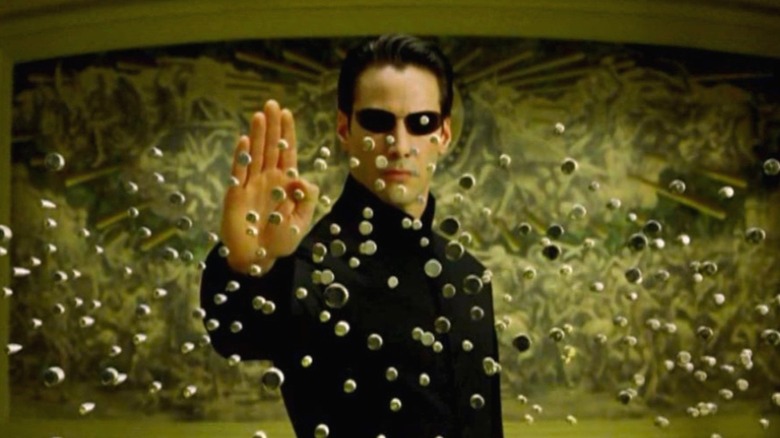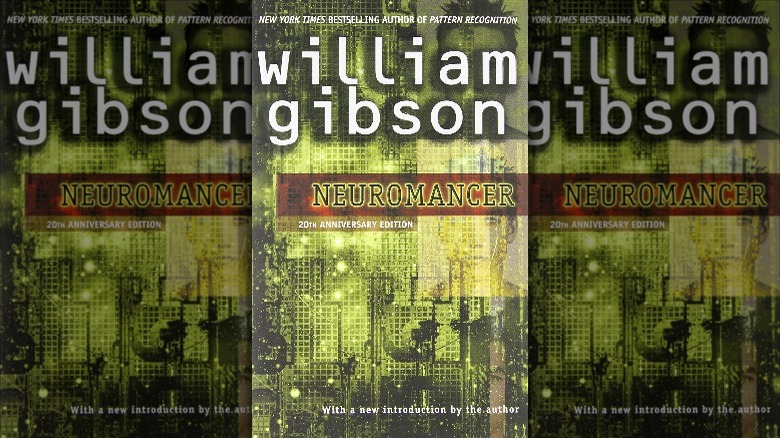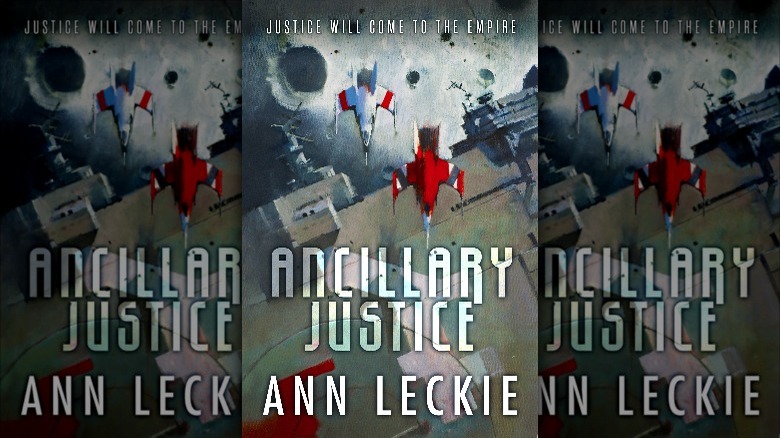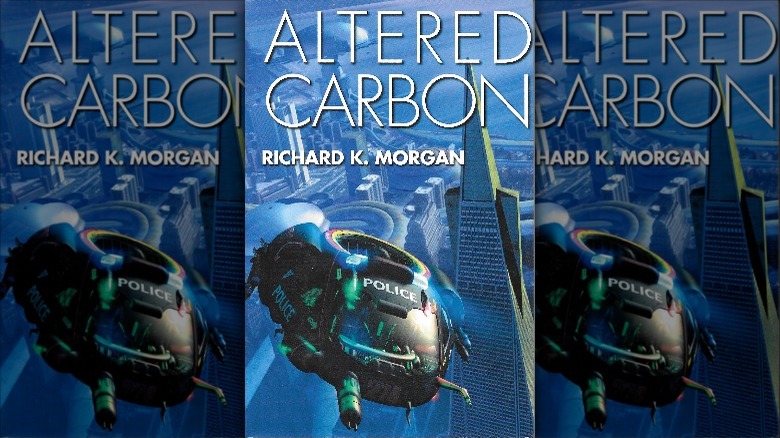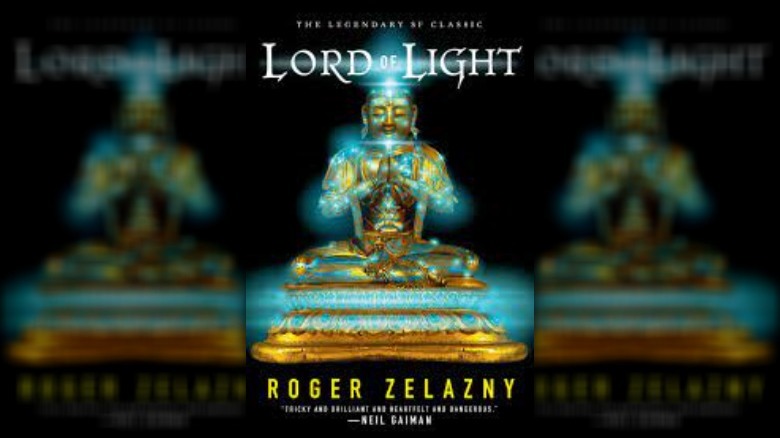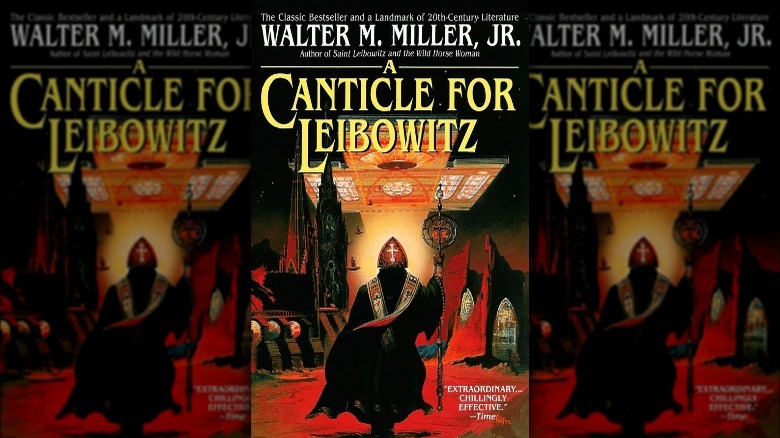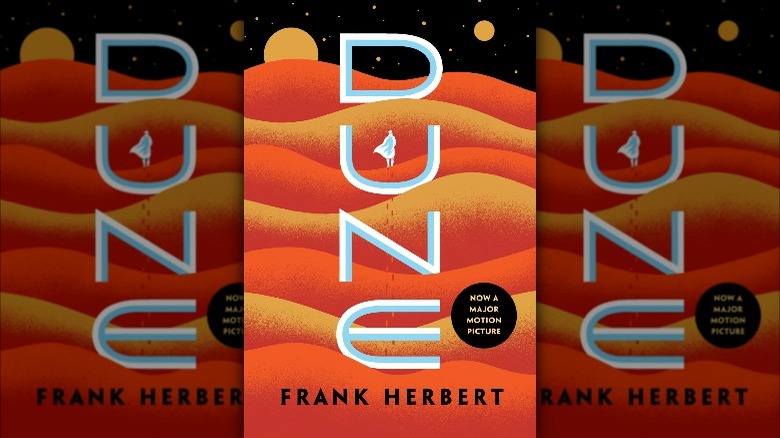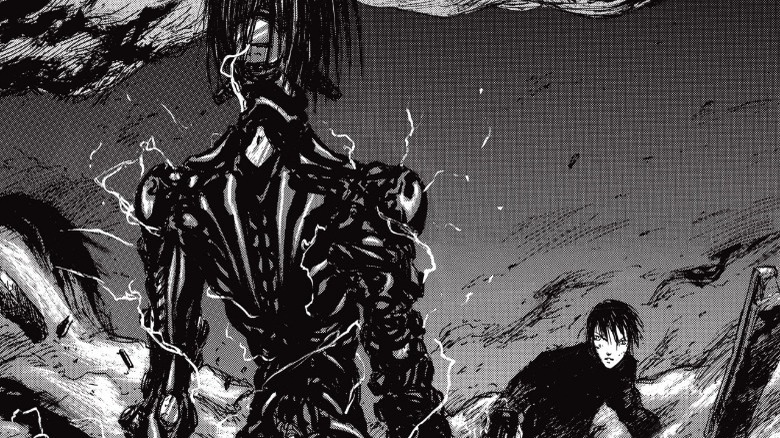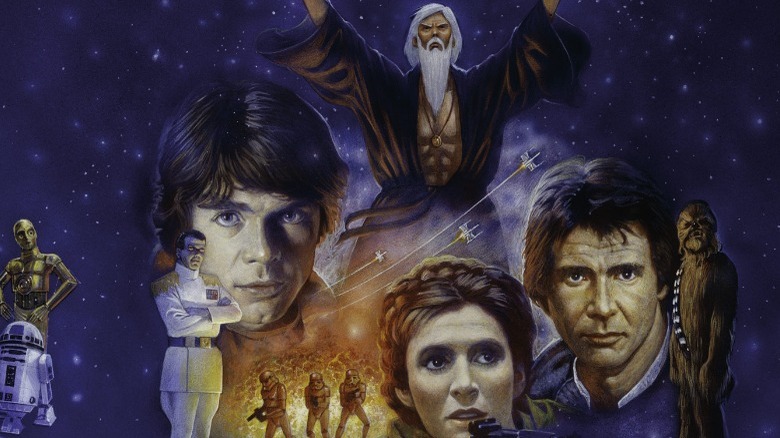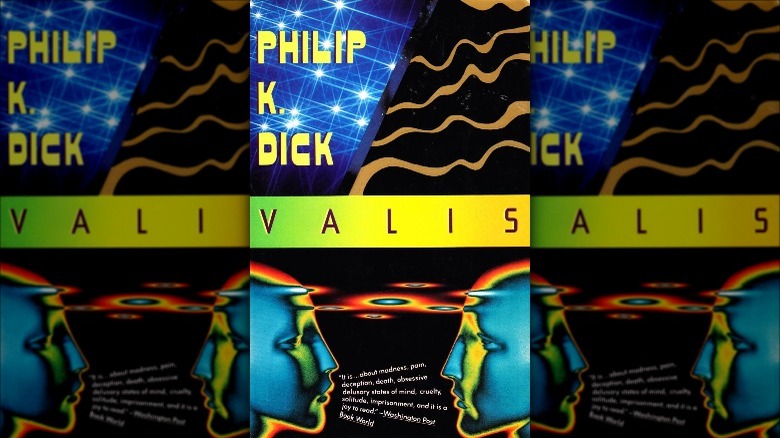10 Books To Read If You Love The Matrix
"The Matrix," like all great stories, was built on some great inspirations. Its basal foundations can be daunting, involving some deep dives into Buddhist theology, philosophy, and the development of AI. The Wachowski sisters drew from three non-fiction grimoires, if you'll pardon the term, to build their world of machine and man. "Out of Control," by Kevin Kelly, is a look at the potential of mechanical evolution. "Introducing Evolutionary Psychology" by Dylan Evans shaped the id of Neo's life. And "Simulacra and Simulation" by Jean Baudrillard is a well-known philosophical treatise that birthed Morpheus' "desert of the real."
These are tough books, but they provide terrific insight into the thought process behind the Matrix itself. Readers who would prefer to take the blue pill instead and jaunt through imaginary worlds in search of a similar fix to Neo's journey through ones and zeros toward his personal nirvana will find plenty of science fiction to enjoy, too. We're going to offer you a complimentary buffet that will explore similar concepts, such as the harsh lives of Chosen Ones, and the ramifications of AI gone rampant.
Neuromancer by William Gibson
If one book is a necessity on any "Matrix"-style recommendation list, it's got to be "Neuromancer." It's the book that codified our modern ideas of cyberpunk, using relatable cultural touchstones to launch readers into the then-fledgling world of true, sentient AI, blending it with noir filth.
The plot begins with a riff on John Carpenter and features an antihero forced into one last job for people he doesn't even like. But Case's similarities to Snake Plissken dry up fast. Case is a cutting-edge but screwed-up hacker who has his access to the matrix — yep, that's where the Wachowskis' term for a VR reality came from — restored in order to help out a high-stakes heist. Instead, Case comes face to face with some of the most famous fictional AI characters this side of SHODAN from "System Shock." Wintermute and the Neuromancer itself are waiting to meet you. If you've never tried out the work that spawned decades of a great new genre fare and inspired the heart of "The Matrix," why? It's not even 300 pages long, it's never out of print, and it reads like a restored Mustang 289.
Ancillary Justice by Ann Leckie
Space opera series are epics about sprawling galaxies with tumultuous politics and worlds at war. "The Matrix" runs on a smaller scale than most of that genre, with its events taking place solely on Earth. But "Ancillary Justice," the start of the "Space Radch" saga by Ann Leckie, is a terrific entry point that overlaps cyberpunk and space opera in ways Neo fans would love.
Our protagonist is Breq, an AI trapped in a human body — the "ancillary" of the title, a cold word meaning a person or subordinate that's part of a support structure — after the destruction of her core personality shell, the starship Justice of Toren. With a future that borrows a little of the grim mortality of "Warhammer 40,000," which is about to become a Henry Cavill series, we find ourselves rooting for the AI over what the galaxy's conquerors, the Radch, have become. Machines have evolved in Leckie's crunchy metal universe, but does that mean they've replaced the need for humanity? The same questions "Matrix" fans might want to investigate come up here, with a protagonist even more dedicated to their furious cause than Agent Smith.
Ghost in the Shell by Masamune Shirow
It's well-known that director Mamoru Oshii's "Ghost in the Shell" is the classic anime adaptation that inspired the cinematography and spirit of "The Matrix." But the original source, Masamune Shirow's manga, is equally worth our time. Blending early digital art with a watercolor-style palette, the initial "Ghost in the Shell" is both lighter in tone and more detailed in its exploration of its cybernetic future.
Though this seminal story begins with AI and human intelligence still at odds, the full saga, which includes two volumes of additional stories, "Man-Machine Interface" and "Human-Error Processor," explores Motoko's evolution as a being that has successfully bridged the two worlds. With her journey comes a riotous, violent, and sometimes sexy world of enhanced humanity, and all new kinds of cybercrime to investigate. There's no Matrix to jack into in this neon-lit city. But a clever enemy can hack into a person's mind and body entirely, and only a handful of trained experts know what to do in that situation. Their success, however, is not guaranteed.
Altered Carbon by Richard K. Morgan
In "The Matrix," the machines were getting all of those battery bodies from somewhere. Further, "Resurrections" showed it was possible to upload a saved consciousness into a new fleshy shell. Neither of these details are new to science fiction, but "Altered Carbon" is a great novel that explores these two concepts together. It was a Netflix cyberpunk TV show, too, for a little while. Pick up the book instead.
In this slightly noir-flavored cyberpunk world, people can protect their consciousness beyond death by using "stacks," a spinal storage device that can be installed into a new human "sleeve" after the body fails. But there's a lot to unpack about privilege and power in this future, with the rich, naturally, benefiting from better upload service and stack protections far beyond the reach of most. It's one of these privileged folks, Laurens Bancroft, who asks Takeshi Kovacs to investigate his own murder. Bancroft's last memories have been meddled with, and as the dominos fall, so too does a sprawling conspiracy to prevent a crucial United Nations resolution from becoming law. It's classic cyberpunk stuff, and like "The Matrix," it asks how important our individual consciousness is in a world where flesh is an afterthought.
Lord of Light by Roger Zelazny
Stepping away from its cyberpunk themes, "The Matrix" also contains some heady commentary about the life of a messiah, as seen through the Buddhist cycle of karma. It's not the first story to do that, however, and those intrigued by Neo's entrapment in a cycle that wasn't ever meant to end might fall in love with Sam, the reluctant Hindu god at the heart of "Lord of Light."
Sam is his shortened name, from Mahasatmatman. That's one of the first clues that this world of Hindu myth isn't quite right. That's no name from the epics, nor is it quite right for what Sam actually is. But Sam could definitely have a drink with Neo. It's up to both of them to navigate a world unhappily forced into a rigid cycle of karma and caste and to break the chains of the "gods" with a revolt that begins in faith. Yes, "Lord of Light" is classic science fiction; these "gods" are evolved humans, using the weapons of their ancient faith to repress alien worlds. And just like the Hindu Yuga cycles, so too will history repeat. Sam must become Buddha (or Samma Sambuddho, for the Samming of it all), and free a world via enlightenment.
A Canticle for Leibowitz by Walter M. Miller Jr.
"The Matrix" dealt with the recurrent cycle of apocalypses, iterations of a synthetic world bent on destroying itself because the machines perceived humanity to prefer that over utopia. There are plenty of science fiction parables to back the machines up in their assumptions, and the most well-known is, arguably, "A Canticle for Leibowitz."
Like "The Matrix," and also rather like the classic Ingmar Bergman film, "The Seventh Seal," you get more out of "Canticle" the more you try to understand its theological underpinnings. But "Canticle" hides black comedy in its priceless relics of the world before it was scourged by nuclear fire, and even darker revelations about humanity itself. Both hopeful and bleak, this book makes no bones about our failures to learn from our own history. It's also quietly, constantly asking its readers to question God's place in all of this. On a brighter note, if you've ever heard a lit nerd make a joke about surviving the end of the world with only a grocery list to guide your morality, this is where it came from. Pastrami, sauerkraut, and bagels. The memory of these foods will last beyond the end of the world, and into the start of the next one.
Dune by Frank Herbert
Odds are, a "Matrix" fan will have at least tried to pick up the dense and heady "Dune," especially after Denis Villeneuve's sensational movie. But keep plugging away. After a first section that throws you into the deep end of a galaxy with all new words and social rules, the saga of "Dune" unveils at least one simpler plot thread to follow: Being the messiah to the thronging masses is an ungodly headache.
Neo fans already understand how heavy that burden can be, and just how much forging along towards your destiny can cost you. Like Neo, Paul Atreides keeps receiving vague snippets of his future, shaped by prophecies and genetic programs set up by others. Sometimes it doesn't feel like he has any free will of his own. The greater "Dune" saga, from the original up through "God Emperor of Dune," delves into that question. The Golden Path is the fervent hope of all the messiahs to spring from the Atreides line. It's an achievement of pure free will, a timeline that can't be predicted, much less controlled. It's a world that would drive the machines of "The Matrix" mad ... but creating it will incur a heavy toll on humanity.
Blame! by Tsutomu Nihei
Often terse and featuring a lusciously detailed nightmare world of machines gone mad, Tsutomu Nihei's "Blame!" didn't reach Western shelves until almost a decade after it began serialization. That caused a little confusion for manga fans at the time, who wondered if Nihei had been inspired by the Wachowskis, when, in fact, the story of Killy's nigh-endless search for a way to stop the machine overgrowth preceded "The Matrix" by almost a decade.
Killy is a laconic fellow armed with a lot of guns. He's not a sympathetic character, and he can't afford to be. He's also no messiah, but he is on the lookout for one. Sort of. This world of AI has gone into rampancy, and it's created a Singularity-style "city" of machinery that's subsumed most of our solar system. Killy's searching for a potentially extinct human genetic code, the only thing that can log back into the system and shut the overgrowth down. Complete at 10 volumes, you'll get some answers as Killy cuts down hateful machines and faces off with the vestiges of humankind. But they might not be the ones you were looking for.
Heir to the Empire, the original Thrawn Trilogy by Timothy Zahn
Going from "The Matrix" to "Star Wars" may feel like a weird jump, but Timothy Zahn's three-book introduction to what's now the Legends continuity stands the test of in-depth science fiction. It deals with the ethics of cloning, delves into corrupted underworlds, and introduces a mind so thorough that he — Grand Admiral Thrawn, in his first incarnation — might as well be a machine.
But most thematically relevant here is the rise of Luke Skywalker as the galaxy's successful chosen one. It's all up to him, from the reformation of the Jedi to personally having to handle major threats to the reborn Republic. To pull it off, he must face the darkest side of himself. Literally, in this case, courtesy of the dead Emperor's secret scientific facilities and a rogue clone that's so powerful and terrifyingly deranged that even Thrawn can't control him. It may be "Star Wars," but it's good stuff, with all the space-opera highlights and terrible days of the Chosen One a fan could want.
Valis by Philip K. Dick
At least one PKD story should be required for any "Matrix" fan, and many of them are great contenders. "Do Androids Dream of Electric Sheep?" is already a cyberpunk baseline, introducing social controls and robotic creatures, but it might be hard to read it and not think, naturally, of "Blade Runner." So let's suggest one that launches beyond the sky, into techno-religion and gnostic symbolism.
"Valis" wasn't pure fiction to its author, as it shaped his lifetime of unreality into something he could step back from and assess. Even PKD admitted that his tale of meeting his alien-influence god might've been a result of drugs or mental illness. Yet, now more than ever, there's something compelling in his sprawling, mind-warping tale of unreality layered over a comforting fiction. The black iron prison PKD briefly describes is the ultimate form of social control, a prison that contains all, though none are aware. What did he see? Reality? The idea of the Matrix, back in 1981? Simulation theory? Decide for yourself, but have some migraine medication on hand. This book's a tricky one to navigate, and by the end, you might have a few new questions about your own reality. When in doubt, follow the white rabbit.
